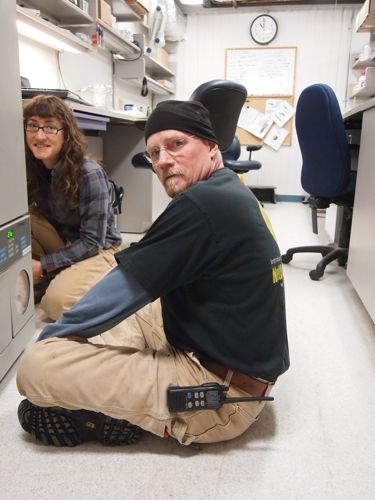Antarctica is one of the harshest environments on earth. There has never been an indigenous population down here. And it's not at all easy to get too. For those reasons, relatively few people have made it down here. There are cruise ships that travel down here but those cost tens of thousands of dollars! So if you want to explore Antarctica and you don't have a lot of money (which is most of us) you have a couple options. You can become a scientist and conduct some sort of research down here or you can apply for a job down here. Between the three American research stations, there are all sorts of jobs.
 Bamma works in operations at Palmer. She has worked at McMurdo also. Here she is in the forklift unloading cargo from the ship
Bamma works in operations at Palmer. She has worked at McMurdo also. Here she is in the forklift unloading cargo from the ship
There is a power plant and water plant on each station, electricians, carpenters, cooks, utility specialists, electronics technician, satellite technician, boating coordinator. There are all kinds of people who keep things running down here.
A lot of the people who work down here do not have homes in the states. Rather they have a storage unit somewhere and they work down here for 6-9 months. Then many of them travel the world in the time they are not working. It can be pretty isolating down here. But it is beautiful and interesting. I have tons of pictures of everyone down here but I can only post a few up here. I don't want to leave anyone out, but this gives you a flavor of the many jobs down here.
 Clair is giving an all clear to move the forklift away. She does a great job on station keeping the Palmer running smoothly.
Clair is giving an all clear to move the forklift away. She does a great job on station keeping the Palmer running smoothly.
 Here is our doctor on station. Dr. Steve Untracht. You're in good hands.
Here is our doctor on station. Dr. Steve Untracht. You're in good hands.
 Here is Bede McCormick. He is a satellite specialist, keeping an eye on our satellite towers and communications.
Here is Bede McCormick. He is a satellite specialist, keeping an eye on our satellite towers and communications.
 Keith is an amazing cook! Diane, our other cook is a little camera shy so you will have to settle with knowing she is equally amazing as a cook! Photo courtesy of Lisa Crockett.
Keith is an amazing cook! Diane, our other cook is a little camera shy so you will have to settle with knowing she is equally amazing as a cook! Photo courtesy of Lisa Crockett.
 Christina Hammock and Jack Anderson work on a freezer in the labs. Christina is the lab tech and helps the scientists and works checking out and monitoring lab equipment. Jack is the utility technician. Which means after the power leaves the generators, he makes sure power and water are running smoothly on station. Photo courtesy of Lisa Crockett
Christina Hammock and Jack Anderson work on a freezer in the labs. Christina is the lab tech and helps the scientists and works checking out and monitoring lab equipment. Jack is the utility technician. Which means after the power leaves the generators, he makes sure power and water are running smoothly on station. Photo courtesy of Lisa Crockett
 Here is Tom Purcell. He is the boating coordinator. Among other things, he keeps up the zodiac boats that we use for the divers and for our recreation when it's clear enough and safe enough to travel to the other islands around here.
Here is Tom Purcell. He is the boating coordinator. Among other things, he keeps up the zodiac boats that we use for the divers and for our recreation when it's clear enough and safe enough to travel to the other islands around here.
If you would like to be on a boat the two research vessels (Laurence M. Gould and Nathaniel B. Palmer) have all sorts of people that work on them. There are marine techs and marine science techs that help the scientists with their work on board the ship. You've seen a number of them at work in my journals. There are deckhands, people that pilot the boat, cooks, and technology personnel; all sorts of jobs.
 Marine techs work both ships and travel all around helping carry out science on the ship among other things
Marine techs work both ships and travel all around helping carry out science on the ship among other things
If you are adventurous or intrigued by any of the things that I have written about in my journals, you might want to think about spending a little time down here after college or focusing your studies on polar sciences.
 Three marine techs and an electronics tech showing you how fun it is to catch fish with a fish pot!
Three marine techs and an electronics tech showing you how fun it is to catch fish with a fish pot!
